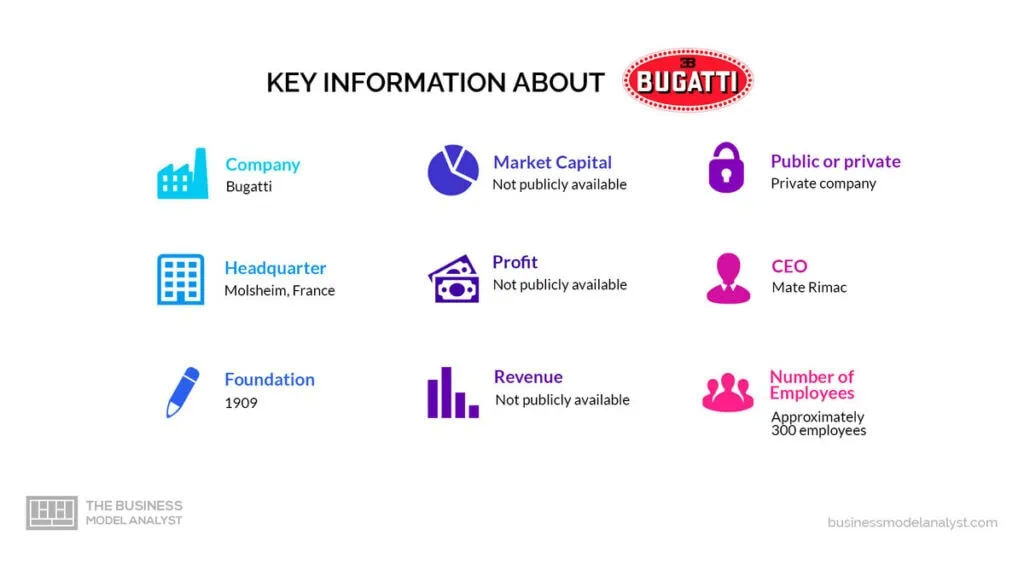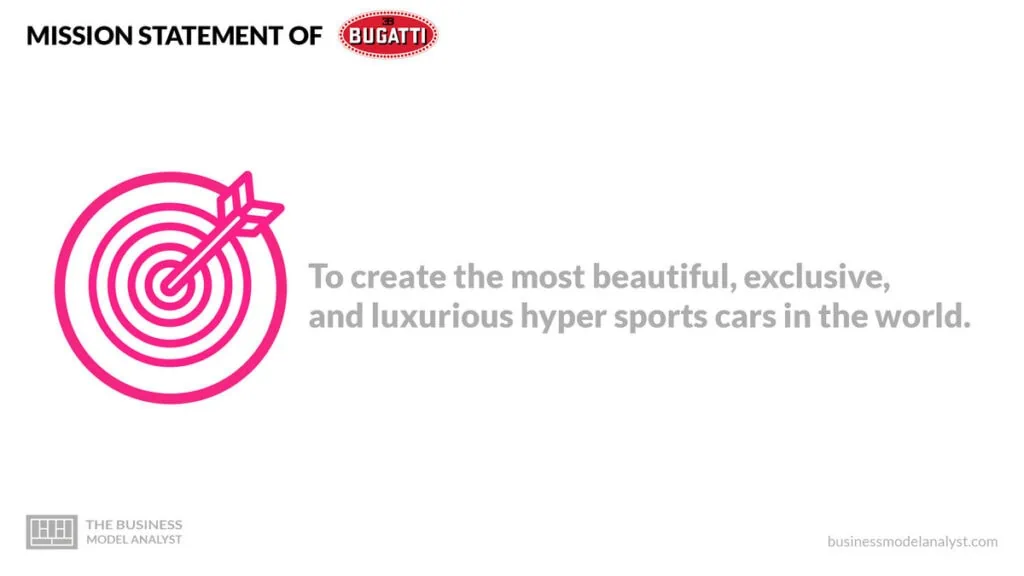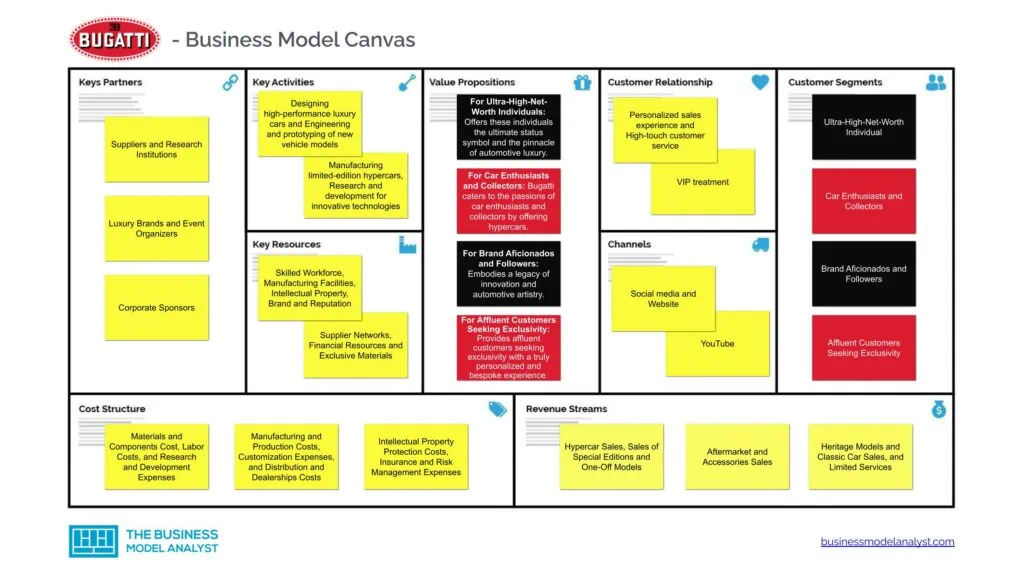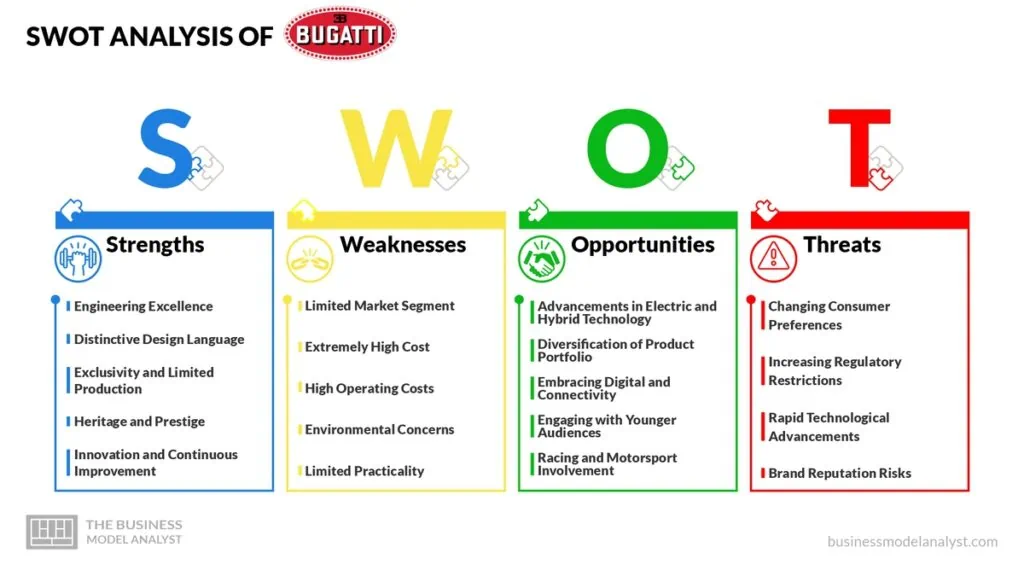The Bugatti Automobiles business model centers around crafting exclusive, high-performance hypercars tailored to an elite clientele. By maintaining limited production runs, the company creates a sense of scarcity and desirability, attracting ultra-wealthy customers seeking exceptional luxury and status symbols. Bugatti’s brand image accentuates its rich heritage and commitment to engineering brilliance, reinforcing its position as a prestigious luxury automaker.
The company sets premium price points for its hypercars, reflecting the top-tier craftsmanship and cutting-edge technology incorporated into each vehicle. Furthermore, Bugatti offers customization options, allowing buyers to personalize their cars to suit their individual tastes, further enhancing the exclusivity of ownership.
By combining innovation, exclusivity, and strong brand identity, Bugatti Automobiles has carved a niche in the hypercar market, catering to a select group of automotive connoisseurs eager to experience the epitome of automotive engineering and luxury.

Contents
A brief history of Bugatti Automobiles
Bugatti Automobiles is a renowned French luxury sports car manufacturer with a rich and storied history. The company was founded by Italian-born French automobile designer Ettore Bugatti in 1909. Ettore had a passion for engineering and a vision to create exceptional automobiles that blended art and technology.
The early years saw Bugatti establish itself as a pioneer in the automotive industry, known for producing high-performance, stylish, and innovative vehicles. One of their most iconic early creations was the Bugatti Type 35, introduced in 1924. The Type 35 dominated the racing circuits, securing numerous victories and earning a reputation for its speed and handling.
Over the years, Bugatti continued to innovate and released several successful models. However, when Ettore Bugatti died in 1947, the company lost its visionary founder and guiding force. Ettore was a talented engineer, designer, and charismatic leader who played a pivotal role in shaping the company’s identity and reputation for building high-performance, luxurious automobiles. His death left a void in the company’s leadership and creative direction.
During the 1950s, the automotive industry underwent significant changes and challenges. The aftermath of World War II also brought economic hardships and the need for companies like Bugatti to adapt to the changing market conditions. Additionally, advances in automotive technology and design during this period posed further challenges for the brand.
Without Ettore’s direct involvement, the Bugatti company struggled to maintain its position as a prominent manufacturer of luxury sports cars. As a result, Bugatti faced financial difficulties during the 1950s, leading to reduced production and sales.
In 1952, the company was sold to the Hispano-Suiza, a Spanish-French engineering firm. However, even under new ownership, Bugatti continued to face financial troubles and couldn’t recapture its former glory. In the following years, Bugatti ceased automobile production entirely and focused on other ventures, such as producing aircraft components. For several decades, the Bugatti brand was dormant in the automotive industry.
It wasn’t until the 1990s that the Volkswagen Group revived the Bugatti name. Under Volkswagen’s ownership, the modern Bugatti Veyron was developed, marking Bugatti’s return as a high-performance hypercar manufacturer.
In 2005, Bugatti introduced the Veyron 16.4, a groundbreaking hypercar that became an instant automotive legend. The Veyron was renowned for its extraordinary speed, boasting a record-breaking top speed of over 250 mph and setting new standards for performance and engineering. Following the success of the Veyron, Bugatti continued to push the boundaries with the Chiron, introduced in 2016. The Chiron further elevated the hypercar game with enhanced power, aerodynamics, and luxurious features.
In July 2021, Volkswagen sold Bugatti to Rimac Automobili and Porsche AG. The deal was structured as a joint venture between Rimac Automobili and Porsche AG. Rimac Automobili owns 55% of the company, while Porsche AG owns the remaining 45%. The sale of Bugatti was a strategic decision by Volkswagen.
Volkswagen is shifting its focus to electric vehicles, and Bugatti is a gasoline-powered brand. The sale of Bugatti to Rimac was a win-win for both companies. It allowed Volkswagen to focus on its electric vehicle strategy, while it allowed Bugatti to access Rimac’s expertise in electric powertrains. The partnership between Rimac and Bugatti will likely produce some of the most exciting hypercars in the world in the coming years.
Who Owns Bugatti Automobiles
Bugatti is currently owned by Rimac Automobili, a Croatian electric hypercar manufacturer. Rimac owns 55% of Bugatti, while Porsche AG owns the remaining 45%. The joint venture was announced in July 2021 and finalized in December of that year.
Bugatti Automobiles Mission Statement

The Bugatti Automobiles mission statement is “to create the most beautiful, exclusive, and luxurious hyper sports cars in the world.”
How Bugatti Automobiles Works
Here’s an overview of how Bugatti Automobiles works:
Design and Engineering
Bugatti’s design and engineering teams work closely together to create groundbreaking vehicles. The design process starts with sketches, 3D models, and computer simulations to conceptualize the car’s appearance and aerodynamics. Engineers develop cutting-edge technologies and innovations to ensure top-tier performance, safety, and comfort.
Manufacturing
Bugatti’s cars are assembled with utmost precision and attention to detail. The company’s state-of-the-art manufacturing facility is located in Molsheim, Alsace, France. Skilled craftsmen and technicians work on each vehicle, hand-assembling various components and using the finest materials to achieve the desired level of quality.
Performance and Testing
Bugatti’s performance is at the core of its brand identity. Each car undergoes extensive testing, including rigorous track testing and simulations. The goal is to achieve blistering speeds, exceptional handling, and unmatched driving dynamics.
Exclusivity
Bugatti Automobiles maintains exclusivity by producing a limited number of cars each year. These vehicles are often custom-built to cater to the preferences of individual clients, ensuring that each Bugatti car is a unique masterpiece.
Innovation
Bugatti is constantly at the forefront of automotive innovation. The company invests heavily in research and development to introduce cutting-edge technologies and materials in its cars. This drive for innovation has led to the production of some of the world’s fastest and most technologically advanced vehicles.
Client Engagement
Bugatti engages directly with its clients throughout the vehicle customization process. Customers have the opportunity to personalize various aspects of their cars, including color choices, interior trims, and unique features, making each Bugatti a reflection of the owner’s preferences.
How Bugatti Automobiles Makes Money
Bugatti Automobiles makes money primarily by selling its high-performance hypercars to a select group of wealthy customers. Here are some key aspects of how Bugatti generates revenue:
Hypercar Sales
Bugatti’s primary revenue source comes from selling its high-performance hypercars. Bugatti produces a limited number of hypercars each year, often in the single digits. These hypercars are meticulously handcrafted, incorporating cutting-edge technology, luxurious materials, and high-performance components.
The exclusivity and prestige associated with Bugatti’s hypercars attract ultra-high-net-worth individuals, car enthusiasts, and collectors who are willing to pay a premium price to own one of these rare and extraordinary vehicles. The hypercars typically feature industry-leading specifications, such as incredibly powerful engines, multiple turbochargers, lightweight carbon-fiber construction, advanced aerodynamics, and top-tier suspension systems.
Bugatti’s hypercars are positioned as the epitome of automotive engineering and luxury, offering unparalleled performance and craftsmanship. As a result, their price tags often reach several million dollars each, generating substantial revenue for the company.
Sales of Special Editions and One-Off Models
In addition to the brand’s standard hypercar models, Bugatti occasionally creates special editions and one-off models. These bespoke vehicles are tailor-made to meet the specific desires and preferences of individual customers. Special editions may commemorate significant milestones, celebrate historical events, or pay homage to iconic Bugatti models from the past.
On the other hand, one-off models are unique creations designed in collaboration with the customer to create a hypercar entirely distinct from any other. The development of these special editions and one-offs allows Bugatti to charge even higher prices, often exceeding their standard hypercars’ already substantial price tags.
These exclusive and limited-production models contribute to Bugatti’s revenue stream while solidifying their reputation as a pinnacle of automotive luxury and customization.
Aftermarket and Accessories Sales
Bugatti leverages its brand recognition to offer branded accessories and merchandise related to its hypercars. These items include lifestyle products, collectibles, and other merchandise branded with the Bugatti logo or associated with specific models.
Additionally, Bugatti sometimes offers performance upgrades and aftermarket parts to enhance existing hypercar owners’ capabilities and personalization options. While the revenue generated from accessories and aftermarket products might be comparatively smaller than hypercar sales, it still adds to Bugatti’s overall profitability.
Heritage Models and Classic Car Sales
Bugatti boasts a rich and storied history in the automotive world, with classic Bugatti models being highly sought after by collectors. Occasionally, Bugatti participates in the restoration or auctioning of vintage Bugatti cars, which generate significant revenue in the classic car market. These heritage models are a testament to the brand’s legacy and contribute to Bugatti’s brand identity.
Limited Services
Bugatti offers exclusive services to its hypercar owners to enhance the overall customer experience and maintain long-term customer loyalty. These services include personalized maintenance and servicing packages tailored to the specific needs of hypercar owners.
Additionally, Bugatti sometimes provides customization options for existing owners, allowing them to further personalize their vehicles according to their preferences. While the revenue generated from limited services might not be the primary driver of Bugatti’s income, it plays a role in maintaining customer satisfaction and fostering a strong brand community.
Bugatti Automobiles Business Model
Let’s take a look at the Bugatti Automobiles Business Model Canvas below:

Bugatti Automobiles Customer Segments
Bugatti Automobiles’ customer segments consist of:
- Ultra-High-Net-Worth Individual: Ultra-High-Net-Worth Individuals are individuals who possess a substantial amount of wealth, often well into the millions or even billions of dollars. These individuals typically include billionaires, successful entrepreneurs, business moguls, top executives, celebrities, and heirs of wealthy families. They have significant financial resources at their disposal, allowing them to afford luxurious and extravagant items, including high-end automobiles like Bugatti hypercars;
- Car Enthusiasts and Collectors: Car enthusiasts and collectors are individuals who have a passionate interest in automobiles and view cars not just as means of transportation but as works of art and engineering marvels. They appreciate unique and rare vehicles with exceptional performance and design. Owning a Bugatti becomes a crowning achievement in their collection of prized automobiles;
- Brand Aficionados and Followers: Brand aficionados and followers are individuals who admire the Bugatti brand, its heritage, and its contribution to the automotive world. They may not necessarily be in the financial position to own a Bugatti hypercar, but they actively engage with the brand through various means. These individuals might follow Bugatti on social media, attend events and gatherings related to the brand, and purchase Bugatti-branded merchandise. Their support and enthusiasm contribute to Bugatti’s brand visibility and influence in the automotive community;
- Affluent Customers Seeking Exclusivity: Affluent customers seeking exclusivity refer to individuals or consumers who are financially prosperous and are actively seeking high-end, unique, and personalized products that are not easily accessible to the general public. These customers have significant purchasing power and are willing to pay a premium for exclusive, luxurious, and prestigious offerings that set them apart from the masses.
Bugatti Automobiles Value Propositions
Bugatti Automobiles’ value propositions consist of:
- For Ultra-High-Net-Worth Individuals: Bugatti offers these individuals the ultimate status symbol and the pinnacle of automotive luxury. The hypercars represent an unrivaled combination of speed, power, and exclusivity. For these discerning individuals, owning a Bugatti is a testament to their extraordinary wealth and an expression of their appreciation for fine craftsmanship and engineering excellence. The rarity and limited production numbers of Bugatti hypercars ensure that these individuals become part of an elite and privileged club of owners worldwide;
- For Car Enthusiasts and Collectors: Bugatti caters to the passions of car enthusiasts and collectors by offering hypercars that are not only high-performance machines but also masterpieces of automotive design and engineering. Each Bugatti model represents a unique chapter in the brand’s storied history, making it a coveted addition to any car collection. The exclusivity and limited availability of Bugatti hypercars appeal to the collector’s desire for rare and exceptional automobiles, adding to the overall allure and value of their collection;
- For Brand Aficionados and Followers: Value Proposition: For brand aficionados and followers, Bugatti embodies a legacy of innovation and automotive artistry. The value proposition lies in being associated with a brand with a storied history and is celebrated for pushing the boundaries of automotive engineering. Engaging with Bugatti, even if not owning a hypercar, allows enthusiasts to connect with a community of like-minded individuals who share a passion for automotive excellence and the Bugatti heritage;
- For Affluent Customers Seeking Exclusivity: Value Proposition: Bugatti provides affluent customers seeking exclusivity with a truly personalized and bespoke experience. The brand’s offering of special editions and one-off models allows customers to create a hypercar that reflects their tastes and preferences, making their Bugatti uniquely theirs. Owning such an exclusive and rare masterpiece ensures that they stand out from the crowd and possess a vehicle that genuinely expresses their distinct identity.
Bugatti Automobiles Channels
Bugatti Automobiles’ channels consist of:
- Social media
- Website
- YouTube
Bugatti Automobiles Customer Relationships
Bugatti Automobiles’ customer relationships consist of:
- Personalized sales experience
- High-touch customer service
- VIP treatment
Bugatti Automobiles Revenue Streams
Bugatti Automobiles’ revenue streams consist of:
- Hypercar Sales
- Sales of Special Editions and One-Off Models
- Aftermarket and Accessories Sales
- Heritage Models and Classic Car Sales
- Limited Services
Bugatti Automobiles Key Resources
Bugatti Automobiles’ key resources consist of:
- Skilled Workforce
- Manufacturing Facilities
- Intellectual Property
- Brand and Reputation
- Supplier Networks
- Financial Resources
- Exclusive Materials
Bugatti Automobiles Key Activities
Bugatti Automobiles’ key activities consist of:
- Designing high-performance luxury cars
- Engineering and prototyping of new vehicle models
- Manufacturing limited-edition hypercars
- Research and development for innovative technologies
- Customization and personalization of vehicles
- Maintaining exclusivity
- After-sales support and service
- Organizing exclusive events and gatherings
Bugatti Automobiles Key Partners
Bugatti Automobiles’ key partners consist of:
- Suppliers
- Research Institutions
- Luxury Brands
- Event Organizers
- Corporate Sponsors
Bugatti Automobiles Cost Structure
Bugatti Automobiles’ cost structure consists of:
- Materials and Components Cost
- Labor Costs
- Research and Development Expenses
- Manufacturing and Production Costs
- Customization Expenses
- Distribution and Dealerships Costs
- Intellectual Property Protection Costs
- Insurance and Risk Management Expenses
Bugatti Automobiles Competitors
- Ferrari: Ferrari is an Italian luxury sports car manufacturer. It is one of the most iconic and recognizable names in the automotive world, renowned for its powerful engines, striking design, and rich racing heritage. Ferrari produces a wide range of high-performance vehicles, including grand tourers, sports cars, and hypercars. Some of the company’s notable models include the Ferrari 488, F8 Tributo, SF90 Stradale, and LaFerrari. The brand’s emphasis on cutting-edge technology, exquisite craftsmanship, and a deep connection with motorsport enthusiasts has solidified its position as a formidable competitor for Bugatti;
- McLaren: McLaren is a British automotive manufacturer and racing team founded in 1963. While initially known for its success in Formula 1, McLaren later ventured into producing road cars. McLaren’s cars are celebrated for their exceptional aerodynamics, lightweight construction, and track-focused performance. The brand’s lineup includes 720S, 765LT, Senna, and Speedtail models. McLaren’s dedication to innovation, precision engineering, and track performance attracts enthusiasts who seek an exhilarating driving experience, making it a strong contender against Bugatti;
- Lamborghini: Founded in 1963, Lamborghini is an Italian luxury sports car manufacturer that has become synonymous with extreme performance and avant-garde design. Lamborghini’s vehicles are characterized by their aggressive styling, powerful engines, and exceptional handling. Models like the Aventador, Huracan, and Urus have garnered immense popularity among supercar enthusiasts worldwide. Lamborghini’s focus on creating visually stunning and emotionally captivating cars has positioned it as a fierce competitor to Bugatti;
- Koenigsegg: Koenigsegg is a Swedish hypercar manufacturer founded in 1994 by Christian von Koenigsegg. The brand is renowned for its dedication to pushing the boundaries of automotive technology and performance. Koenigsegg produces limited-production hypercars known for their extreme power, lightweight construction, and innovative features. Notable models include the Koenigsegg Jesko, Gemera, and Regera. The company’s small-scale production approach, focus on innovation, and record-breaking achievements have established it as a worthy rival to Bugatti;
- Pagani: Pagani is an Italian hypercar manufacturer founded in 1992 by Horacio Pagani. The brand’s philosophy revolves around blending art and engineering to create automotive masterpieces. Pagani’s hypercars are characterized by their attention to detail, luxurious interiors, and exquisite craftsmanship. Models like the Huayra and Huayra Roadster exemplify Pagani’s commitment to exclusivity, performance, and individuality. With a limited number of vehicles produced each year, Pagani competes directly with Bugatti for the attention of high-end car collectors and enthusiasts.
Bugatti Automobiles SWOT Analysis
Below, there is a detailed SWOT analysis of Bugatti Automobiles:

Bugatti Automobiles Strengths
- Engineering Excellence: Bugatti is known for its engineering prowess, and its vehicles are a testament to cutting-edge automotive technology. Each Bugatti car is a masterpiece of precision engineering, incorporating advanced materials, aerodynamics, and innovative solutions to achieve extraordinary performance levels;
- Distinctive Design Language: Bugatti’s design language is characterized by a perfect blend of elegance, aerodynamics, and aggressive styling. The brand’s signature C-line, horseshoe grille, and iconic Bugatti badge are instantly recognizable, giving their cars a unique and unmistakable identity;
- Exclusivity and Limited Production: Bugatti maintains a policy of limited production, creating an aura of exclusivity around its hypercars. This limited supply, coupled with high demand, increases the desirability and collectible value of Bugatti vehicles;
- Heritage and Prestige: Bugatti has a rich history and heritage dating back to the early 20th century. The brand’s association with iconic models like the Bugatti Type 35 and its founder Ettore Bugatti has contributed to its prestige and legendary status in the automotive world;
- Innovation and Continuous Improvement: Bugatti consistently strives to push the boundaries of what’s possible in the automotive industry. They are continuously innovating and exploring new technologies to enhance their vehicles’ performance, efficiency, and safety.
Bugatti Automobiles Weaknesses
- Limited Market Segment: Bugatti produces hypercars with astronomical price tags, significantly narrowing its potential customer base. The ultra-high-end market segment for hypercars is relatively small, limiting the number of potential buyers;
- Extremely High Cost: Bugatti’s hypercars come with a staggering price, making them unaffordable for the vast majority of car buyers. The cost of ownership, maintenance, and insurance for Bugatti vehicles can also be prohibitive;
- High Operating Costs: Bugatti hypercars are engineered for extreme performance, and as a result, they can have high operating costs, including fuel consumption, maintenance, and servicing expenses;
- Environmental Concerns: Hypercars, including Bugatti models, are known for their high emissions and fuel consumption. As environmental concerns continue to grow, such performance-oriented vehicles may face criticism and scrutiny;
- Limited Practicality: Bugatti hypercars are designed for speed and performance but lack a few practical features in other luxury vehicles. They are more focused on track use or special occasions.
Bugatti Automobiles Opportunities
- Advancements in Electric and Hybrid Technology: Bugatti can explore electric and hybrid hypercar opportunities with the automotive industry shifting toward sustainability and eco-friendliness. Embracing greener technologies would allow Bugatti to maintain its high-performance reputation while also appealing to environmentally conscious customers;
- Diversification of Product Portfolio: While Bugatti is primarily known for its hypercars, there may be opportunities to diversify its product offerings. For example, expanding into luxury goods, accessories, or lifestyle products branded with the Bugatti name could leverage the brand’s prestige beyond the automotive sector;
- Embracing Digital and Connectivity: Bugatti can leverage advancements in digital technology to enhance the in-car experience and connectivity features. Integrating cutting-edge infotainment systems, driver-assistance technologies, and seamless connectivity would cater to the expectations of modern luxury car buyers;
- Engaging with Younger Audiences: Bugatti can work on engaging with younger audiences to ensure long-term sustainability. Utilizing social media, experiential marketing, and events targeted at younger luxury enthusiasts can help create a future customer base for the brand;
- Racing and Motorsport Involvement: Bugatti can re-enter motorsport events like endurance races to showcase its engineering capabilities and racing heritage. Success on the track can translate into a positive brand image and credibility.
Bugatti Automobiles Threats
- Changing Consumer Preferences: Shifts in consumer preferences, especially towards sustainability and eco-friendly products, could threaten Bugatti’s traditional high-performance, high-emission hypercars. Customers may prioritize environmentally conscious options over purely performance-oriented vehicles;
- Increasing Regulatory Restrictions: Stricter emission regulations and other automotive-related policies could pose challenges for Bugatti’s hypercars. Complying with evolving emission standards without compromising on performance may require significant investments in research and development;
- Rapid Technological Advancements: The automotive industry is witnessing rapid advancements in technology, including electric vehicles, autonomous driving, and connectivity features. Bugatti must stay at the forefront of innovation to keep up with changing customer expectations and preferences;
- Brand Reputation Risks: Any safety issues or negative publicity related to Bugatti’s vehicles could damage the brand’s reputation and erode consumer trust.
Conclusion
Bugatti Automobiles has masterfully crafted a business model around exclusivity, craftsmanship, and engineering brilliance. By meticulously maintaining limited production runs, the company has cultivated a sense of rarity and allure, enticing an elite clientele of ultra-wealthy customers who seek not just high-performance hypercars but status symbols that symbolize luxury and opulence.
While Bugatti’s business model has been successful, it does face specific challenges. The potential customer base is relatively small, with hypercars being niche products catering to a specific segment of ultra-wealthy buyers. As a result, Bugatti must employ a careful and targeted marketing strategy to reach and appeal to potential customers effectively.
Moreover, like all automakers, Bugatti must adhere to various regulations and safety standards in different markets. Complying with these requirements while delivering hypercars with extraordinary performance can be complex.

